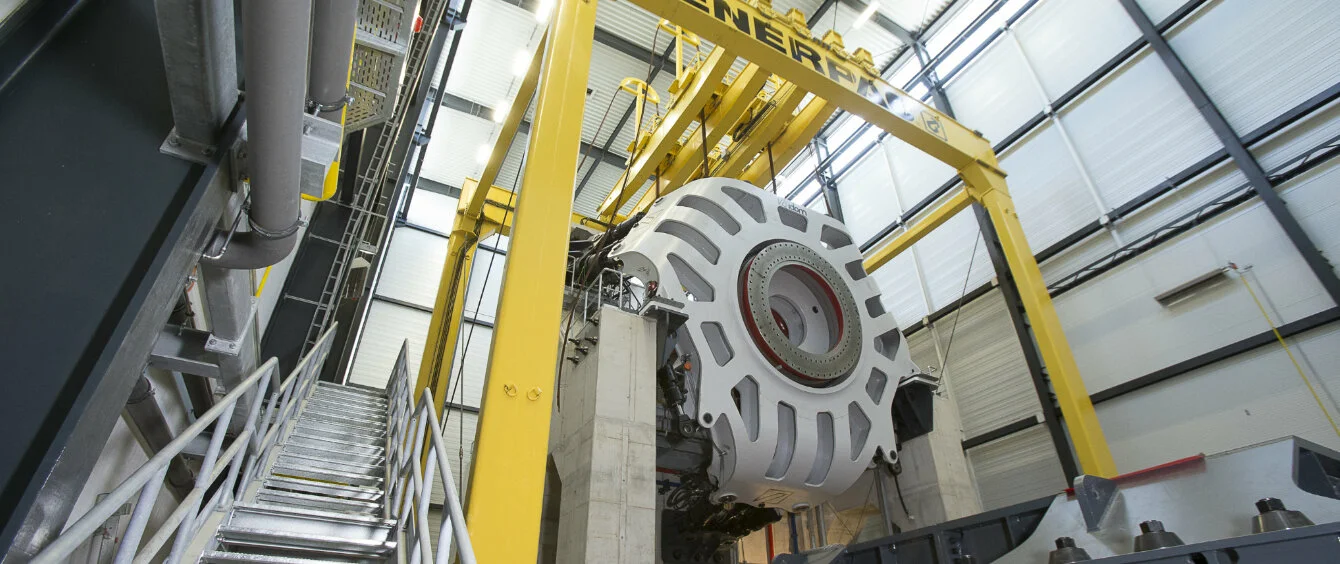Converting wind and solar energy into electric power is becoming an increasingly straightforward affair. Until recently, this has predominantly meant that plants have had to be throttled less and less in order to prevent grid overloads, with the result that photovoltaic systems and wind turbines are now generally able to input electricity into the grid whenever wind and solar energy are available. Before now, other generation units such as coal or gas-fired and hydroelectric power stations have taken on the lion’s share when it comes to load balancing in the grid.
But this may soon change, according to Gesa Quistorf, who, together with her team at the Fraunhofer Institute for Wind Energy Systems IWES in Bremerhaven, is currently developing a grid simulator for offshore wind turbines. In an interview with en:former, she gives us the 411 on grid simulators, what they are needed for and why we can soon expect big things from wind turbines.
en:former: Ms. Quistorf, the capacity of the largest wind turbines in the world currently sits at twelve megawatts (MW). Your simulator is designed to be able to test turbines with capacities of up to 20 MW. Is this a taste of what’s to come?
Well, although we don’t know exactly what the future holds, we do know that the output of wind turbines (WTGs) has grown rapidly in recent years and plans for 15 MW turbines are already in the works. Plus we want to leave a certain amount of wiggle room for all eventualities. An added benefit is that we can then also test entire segments of wind farms with smaller WTGs.
While we’re on the subject: What is a grid simulator?
A grid simulator is a system which is able to simulate regular grid operation with normal voltage fluctuations as well as short circuits and frequency changes. In other words, a plant being tested using our simulator wouldn’t actually be able to tell the difference from normal operation, so to speak.
And you’re now building a particularly large grid simulator?
Our grid simulator won’t just be designed to handle particularly large capacities, it will also be mobile. Smaller WTGs are usually analysed on test stands, where an engine, connected to a generator, simulates various wind speeds whilst a stationary grid simulator tests grid compatibility. Newer WTGs are too large for conventional test stands, so it makes more sense from an economical perspective to build a mobile grid simulator and test the turbines in field trials instead of upgrading the existing test stand engines.
Does that mean your simulator will need to travel by boat to test offshore turbines?
No, offshore turbines are also tested on land – usually near the coast so the wind conditions are as close as possible to those at sea.
Which turbines need to be tested in this way?
Before a system is connected to the grid – no matter the type of plant, whether it’s a WTG, a PV array or a CHP unit – the manufacturer has to prove that its design meets the grid compatibility requirements of the respective grid operator. Therefore, the prototype needs to be tested. Provided everything goes well, it is then approved and can be mass produced.
And what exactly do you look for during these tests?
Here at Fraunhofer IWES, we specialise in WTGs. The different teams test almost all components of the wind turbine in question: from the tip of the rotor blade to the hub and the nacelle right down to the transformer, i.e. the source of the electricity which flows into the grid. This is exactly where our team comes in. We check whether the finished turbine does what it was ultimately built for, namely to reliably feed electricity into the grid.
How reliably can a system output electricity when it is dependent on the weather?
Well, in the offshore sector in particular, wind actually blows fairly constantly. For us, however, it’s more a question of how reliably a plant can feed the available energy into the grid as electricity. It’s also a question of how well the plant can be ramped up or down as demand fluctuates. Then we have to make sure that the turbine doesn’t simply switch off in the event of a short circuit in its grid.
But that would also be bad news for a gas-fired power station.
Exactly – so you see that requirements for wind turbines and conventional power plants are becoming increasingly similar. In the past, it was enough for a WTG to simply feed electricity into the grid. But the larger the contribution to the electricity mix, the more important it is to be able to predict that contribution. At present, we assume that 65 percent renewable energy or above can cause instability in the grid. To avoid this, we need to deploy new control strategies, which mean wind turbines will need to take on more responsibility.
How so?
Wind turbines, together with other renewables and storage facilities for example, will soon be called upon to act as an operating reserve – i.e. they will need to help stabilise the power grid without the help of conventional power stations. They will also need to be able to provide a black start, which means wind turbines will need to be able to restart independently in the event of a power failure in order to restore the grid. Until now, they have been reliant on power from the grid to turn their rotors to face the wind. Our grid simulator will be able to prove that these turbines tick all the necessary boxes.
Gesa Quistorf heads the Mobil-Grid-CoP (Mobile Test Facility for Grid Compliance Testing) research project at the Fraunhofer Institute for Wind Energy Systems IWES. The project is subsidised by the German Ministry of Economics and Energy (BMWi) to the tune of EUR 12.7 million.

